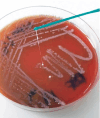Hypervirulent Klebsiella pneumoniae (hv Kp): Overview, Epidemiology, and Laboratory Detection
- PMID: 39911145
- PMCID: PMC11792540
- DOI: 10.20411/pai.v10i1.777
Hypervirulent Klebsiella pneumoniae (hv Kp): Overview, Epidemiology, and Laboratory Detection
Abstract
Klebsiella pneumoniae (Kp) is a Gram-negative pathogen responsible for both hospital- and community-acquired infections. Kp is classified into 2 distinct pathotypes: classical K. pneumoniae (cKp) and hypervirulent K. pneumoniae (hvKp). First described in Taiwan in 1986, hvKp are highly pathogenic and characterized by unique phenotypic and genotypic traits. The hypermucoviscous (hmv) phenotype, generally marked by overproduction of the capsule, is often associated with hvKp, although recent studies show that some cKp strains may also have this characteristic. Furthermore, hvKp can cause severe community-acquired infections in healthy people and have been associated with metastatic infections such as liver abscess, meningitis, and endophthalmitis. HvKp are increasingly being reported in hospital-acquired settings, complicating treatment strategies. In particular, while hvKp have historically been antibiotic-susceptible, multidrug-resistant (MDR) strains have emerged and pose a significant public health threat. The combination of high virulence and limited antibiotic options demands further research into virulence mechanisms and rapid identification methods. This review discusses the epidemiology of hvKp and their virulence factors, highlighting the importance of phenotypic and non-phenotypic tests, including next-generation molecular diagnostics, for the early detection of hvKp.
Keywords: ESBL; Klebsiella pneumoniae; WGS; carbapenemases; detection; epidemiology; hvKp; hypermucoviscous; in vivo; string test; virulence.
Copyright © 2025 Pathogens and Immunity.
Conflict of interest statement
None declared
Figures
Similar articles
-
Antimicrobial Resistance Pattern, Pathogenicity and Molecular Properties of Hypervirulent Klebsiella pneumonia (hvKp) among Hospital-Acquired Infections in the Intensive Care Unit (ICU).Microorganisms. 2023 Mar 6;11(3):661. doi: 10.3390/microorganisms11030661. Microorganisms. 2023. PMID: 36985234 Free PMC article.
-
Comparative Analysis of Clinical and Genomic Characteristics of Hypervirulent Klebsiella pneumoniae from Hospital and Community Settings: Experience from a Tertiary Healthcare Center in India.Microbiol Spectr. 2022 Oct 26;10(5):e0037622. doi: 10.1128/spectrum.00376-22. Epub 2022 Aug 31. Microbiol Spectr. 2022. PMID: 36043878 Free PMC article.
-
Distinct epigenetic signatures of classical and hypervirulent Klebsiella pneumoniae.mSphere. 2024 Jan 30;9(1):e0046423. doi: 10.1128/msphere.00464-23. Epub 2023 Dec 19. mSphere. 2024. PMID: 38112443 Free PMC article.
-
Hypervirulent Klebsiella pneumoniae - clinical and molecular perspectives.J Intern Med. 2020 Mar;287(3):283-300. doi: 10.1111/joim.13007. Epub 2019 Nov 21. J Intern Med. 2020. PMID: 31677303 Free PMC article. Review.
-
"Superbugs" with hypervirulence and carbapenem resistance in Klebsiella pneumoniae: the rise of such emerging nosocomial pathogens in China.Sci Bull (Beijing). 2023 Nov 15;68(21):2658-2670. doi: 10.1016/j.scib.2023.09.040. Epub 2023 Sep 29. Sci Bull (Beijing). 2023. PMID: 37821268 Review.
Cited by
-
Biofilm Formation, Antibiotic Resistance, and Virulence Analysis of Human and Avian Origin Klebsiella pneumoniae from Jiangsu, China.Vet Sci. 2025 Jun 30;12(7):628. doi: 10.3390/vetsci12070628. Vet Sci. 2025. PMID: 40711288 Free PMC article.
-
Phenotypic and Genotypic Characterization of ESBL-, AmpC-, and Carbapenemase-Producing Klebsiella pneumoniae and High-Risk Escherichia coli CC131, with the First Report of ST1193 as a Causative Agent of Urinary Tract Infections in Human Patients in Algeria.Antibiotics (Basel). 2025 May 9;14(5):485. doi: 10.3390/antibiotics14050485. Antibiotics (Basel). 2025. PMID: 40426551 Free PMC article.
-
Detection of Hypervirulence Genes and Drug Resistance in Klebsiella pneumoniae in Diagnostic Microbiology.Scientifica (Cairo). 2025 Aug 3;2025:8545710. doi: 10.1155/sci5/8545710. eCollection 2025. Scientifica (Cairo). 2025. PMID: 40787605 Free PMC article.
-
"Global divide in carbapenem resistance and hypervirulence of Klebsiella pneumonia: comparing trends in India and developed nations"- a comprehensive review.J Antibiot (Tokyo). 2025 Jul;78(8):457-471. doi: 10.1038/s41429-025-00833-8. Epub 2025 Jun 3. J Antibiot (Tokyo). 2025. PMID: 40461635 Review.
-
Hypervirulent Klebsiella pneumoniae: Insights into Virulence, Antibiotic Resistance, and Fight Strategies Against a Superbug.Pharmaceuticals (Basel). 2025 May 15;18(5):724. doi: 10.3390/ph18050724. Pharmaceuticals (Basel). 2025. PMID: 40430542 Free PMC article. Review.
References
-
- Chang D, Sharma L, Dela Cruz CS, Zhang D.. Clinical Epidemiology, Risk Factors, and Control Strategies of Klebsiella pneumoniae Infection. Front Microbiol. 2021;12:750662. doi: 10.3389/fmicb.2021.750662. PubMed PMID: 34992583; PMCID: PMC8724557. - DOI - PMC - PubMed
-
- Paczosa MK, Mecsas J.. Klebsiella pneumoniae: Going on the Offense with a Strong Defense. Microbiol Mol Biol Rev. 2016;80(3):629–61. doi: 10.1128/MMBR.00078-15. PubMed PMID: 27307579; PMCID: PMC4981674. - DOI - PMC - PubMed
-
- Taraghian A, Nasr Esfahani B, Moghim S, Fazeli H.. Characterization of Hypervirulent Extended-Spectrum β-Lactamase-Producing Klebsiella pneumoniae Among Urinary Tract Infections: The First Report from Iran. Infect Drug Resist. 2020;13:3103–11. doi: 10.2147/IDR.S264440. PubMed PMID: 32982325; PMCID: PMC7489934. - DOI - PMC - PubMed
-
- Liu C, Du P, Xiao N, Ji F, Russo TA, Guo J.. Hypervirulent Klebsiella pneumoniae is emerging as an increasingly prevalent K. pneumoniae pathotype responsible for nosocomial and healthcare-associated infections in Beijing, China. Virulence. 2020;11(1):1215–24. doi: 10.1080/21505594.2020.1809322. PubMed PMID: 32921250; PMCID: PMC7549996. - DOI - PMC - PubMed
-
- Catalan-Najera JC, Garza-Ramos U, Barrios-Camacho H.. Hypervirulence and hypermucoviscosity: Two different but complementary Klebsiella spp. phenotypes? Virulence. 2017;8(7):1111–23. doi: 10.1080/21505594.2017.1317412. PubMed PMID: 28402698; PMCID: PMC5711391. - DOI - PMC - PubMed
Publication types
LinkOut - more resources
Full Text Sources

